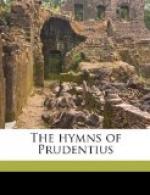officers for some of the most lucrative posts in the provinces.
Though in the translation the usual meaning has been given to
militia, it must be regarded as uncertain in the absence of
more definite information regarding the office held by Prudentius.
24 The consulship of Salia (or Salias) belongs
to the year 348, the
date of the birth of
Prudentius. An inscription (quoted by Migne from
Muratorius, Nov.
Thes. Inscrip., i. 379) has been found in
the
monastery of St. Paul’s
outside the city bearing the words
FILIPPO . ET . SALLIA . COSS
I
1 Of this poem lines 1-8, 81-84, 97-100, were
included in the Roman
Breviary as a hymn to
be sung at Lauds, on Tuesday.
2 The allusions to the cock in this and the following
poem (ii. 37-55)
were doubtless inspired
by the lines of Ambrose in his morning hymn
beginning Aeterne
rerum conditor. Cf. ll. 5-8 and 16-24:
"praeco diei iam sonat noctis profundae pervigil, nocturna lux viantibus a nocte noctem segregans.
* * * * *
surgamus ergo strenue: gallus iacentes excitat, et somnolentos increpat: gallus negantes arguit.
gallo canente spes redit, aegris salus refunditur, mucro latronis conditur, lapsis fides revertitur."
Translation.
“Dawn’s herald now begins to cry,
Lone watcher of the nightly sky:
Light of the dark to pilgrims dear,
Speeding successive midnights drear.
* * * * *
Brisk from our couch let us arise!
Hark to the cock’s arousing cries!
He chides the sluggard’s slumbrous ease,
And shames his unconvincing pleas.
At cock-crow Hope revives again,
Health banishes the stress of pain,
Sheathed is the nightly robber’s sword,
And Faith to fallen hearts restored.”
See also Ambrose, Hexaem., v. 24, for an eloquent passage in the same strain. The cock was the familiar Christian symbol of early rising or vigilance, and numerous representations of it are found in the Catacombs. Cf. the painting from the Catacomb of St. Priscilla reproduced in Bottari’s folio of 1754, where the Good Shepherd is depicted as feeding the lambs, with a crowing cock on His right and left hand. It is also a symbol of the Resurrection, our Lord being supposed to have risen from the grave at the early cockcrowing: see l. 65 et seq. In l. 16 the first bird-notes are interpreted by the poet as a summons to the general judgment. Cf. Mark xiii. 35: “Ye know not when the lord of the house cometh, whether at even, or at midnight, or at cockcrowing, or in the morning.” This




